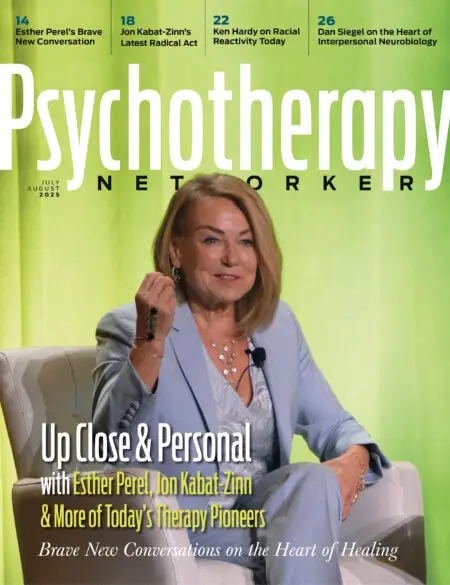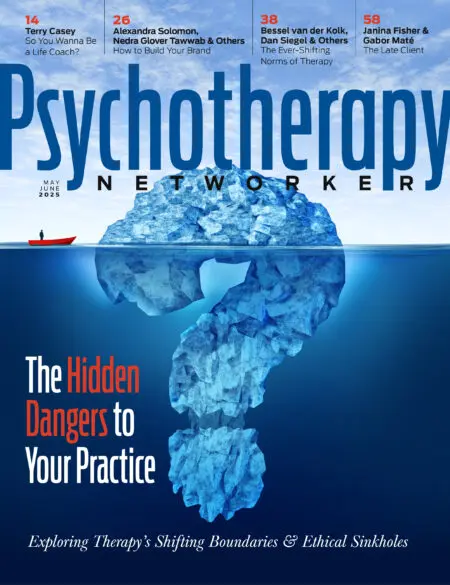When it comes to improving our knowledge as therapists, I’ve found that while the process of learning is hard, the process of unlearning is even harder. When I became a therapist in 1987, our field’s understanding of autism was limited—and I kept up as it evolved. But five years ago, decades into working with young Autistic clients and their families, a mother inadvertently changed what I thought I knew about the Autistic experience.
In a tireless effort to advocate for her son, she sent me article after article on Pathological Demand Avoidance (PDA). I’d heard of PDA before, but as I dove deeper into the literature, I had a lightbulb moment, followed my many more. I started to better understand many of my previous clients; through a PDA lens, it was clear why they hadn’t made progress using conventional therapy and behavioral methods. Suddenly, I was unlearning the picture of autism that much of my career had been built upon.
Commonly thought to be a subtype or profile of autism, PDA is a nervous system difference that involves an overactive threat response to a perceived lack of autonomy and equality. To cope with this chronic source of dysregulation and reduce their overwhelming anxiety, PDAers often seek safety and regulation through behaviors that help them feel in control of other people and situations. Although the concept of PDA has been around since the 1980s, when it came out of the United Kingdom, it’s not recognized as an official diagnosis in the United States. In other words, you won’t find it in the DSM.
Many people who work in the autism community have heard of PDA, but even autism awareness advocates can be quick to dismiss it as another unnecessary label related to the wide spectrum of neurodivergence. Many don’t fully appreciate it as a unique experience, one that’s often mislabeled and misdiagnosed, and left unsupported. After all, PDAers don’t usually fit the stereotypical presentation of autism: they tend to make eye contact and be quite socially driven. When these kids feel secure and in control, they can appear very confident and engaging. They can also appear content even when they’re suffering immensely inside.
When the suffering is externalized, the resulting meltdowns can be intense and scary, and the accumulative stress often leads to long-term nervous system burnout, where the child is unable to function. Yet teachers, pediatricians, and even family members often dismiss these extreme nervous system responses as a function of “problematic parenting.” Maybe they’ll recommend a book on how to hold boundaries, or they’ll relay some “war stories” of their own. Too often, they fail to realize that the PDAer’s overactive amygdala is stuck in fight-protection mode, or that they’re in burnout from masking all day to cope with an environment that’s not built to support them.
In 2020, I founded PDA North America, a fast-growing nonprofit dedicated to raising awareness of PDA. We offer regular webinars, as well as parent groups, trainings, and an annual conference. Our thousands of members are desperate to bring PDA out of the shadows, so PDAers and their families can find the validation and support they need. I often hear statements from parents of PDAers like, “None of the other diagnoses my child was given—ASD, OCD, ADHD, even ODD—ever really fit.” Or, “I tried to follow the guidance I was given on parenting a child with behavioral challenges, but none of it worked.” Or, “My gut told me we were missing something about my kid, but everyone just made me feel like I was crazy.”
These kinds of statements aren’t surprising: a 2018 study from the PDA Society polling U.K. families with PDAers found that nearly 70 percent of parents reported feeling a lack of acceptance of PDA to be a barrier to getting support. Sixty-six percent reported that they felt what their child needed was either “not considered, not properly understood, or not properly implemented.”
At a basic level, even the name PDA is grossly misleading: not only is pathological stigmatizing, but demand avoidance does little to capture what’s actually going on for individuals who fit this neurotype. Fortunately, there’s a growing movement to rename PDA as Pervasive Drive for Autonomy. After all, at its core, PDA is about autonomy—and a nervous system that experiences threat when it feels pressured to take action.
Of course, maintaining a sense of autonomy in a society like ours, especially for kids, is impossible without significant accommodations. Stressed PDAers will experience a fluctuating window of tolerance for the basic tasks required in daily life, like transitioning from one activity to the next (a demand they don’t always have control over), eating and toileting (hunger and needing to go to the bathroom being internal demands they can’t control), and going to school (where they face many demands to complete tasks or sit still, putting significant dings in their extraordinary need for autonomy). Eventually, many PDAers can no longer tolerate mainstream school. The same 2018 study of U.K. families with PDAers found that nearly 70 percent of children with PDA had trouble tolerating their school environment. In burnout, many can’t leave the house, even for activities they enjoy and want to participate in.
When I see families in situations like this, it’s easy to understand why we describe PDA, and autism more broadly, as a nervous system disability. For PDAers, it’s not a matter of won’t; it’s a matter of can’t. They can’t eat the thing you’re telling them to eat, answer the question you’re telling them to answer, play the game you’re telling them to play—because you’re telling them to do it. The problem is most people don’t see PDA this way. And leaning on traditional strategies to get a kid (or even an adult) to do things—rewarding, punishing, bribing, shaming, cajoling, threatening, even thoughtful explaining—won’t work with a PDAer whose sense of autonomy is so closely linked to their sense of safety. This isn’t about willful refusal, or even anxious avoidance: this is a brain at war with itself. PDAers describe being in a constant state of “push-pull”—a hard way to live that, without the proper support, easily leads to burnout.
According to Donna Henderson, a clinical neuropsychologist for over three decades and coauthor of Is This Autism?: A Guide for Clinicians and Everyone Else, being Autistic means “that you have a different kind of nervous system.” But a PDAer’s nervous system is next level, even for an Autistic person. And being in near-constant protection mode often translates in kids to behaviors like hitting, biting, throwing, using hurtful language, experiencing meltdowns that can last hours, or freezing and completely shutting down. Even adult PDAers who have good support and a cache of coping mechanisms can struggle intensely with traditional work environments, rules, and relationships.
If it all sounds overwhelming, it’s helpful to reframe PDA meltdowns as panic attacks, not misbehavior. Panic attacks usually evoke empathy and support from other people; whereas misbehaviors usually evoke punishment, or at the very least, a firm reprimand. Obviously, the latter will only activate a nervous system in protection mode, but less obviously, so will talking too much and moving too close to them, even in an attempt to validate their feelings or gently explain the “natural consequences” of their behaviors. If you’re not in your thinking brain, how can you be expected to process these actions as anything bur further threats?
And yet, as we all know, a distressed nervous system is in need of close connection. Polyvagal Theory posits that neuroception, essentially the body’s subconscious surveillance system, is constantly on the lookout for any possible threats to safety and connection. For PDAers, whose neuroception is so acute it perceives threat where others don’t, connection becomes even more essential. So therein lies the challenge for caregivers: connecting with a kid whose dysregulation often manifests in “aggressive” behaviors, and in ways that may feel counterintuitive to neurotypical people who don’t know about PDA.
“Please Put on Your Shoes!”
I recently met the parent of a funny, creative, precocious, sweet four-year-old who was teetering on the verge of burnout and flew into a dysregulated rage if he wasn’t the first person to go through a door, or if anyone tried to help him open any door. If his parents touched his socks before he felt ready to put them on, or took a bite of food before he felt ready to eat, he’d scream that he hated them and demand they throw away the socks or food entirely, making eating and getting dressed nearly impossible on some days. Then, he’d cry in agony because he actually wanted to put on his socks and eat his food and go through the door that was too heavy for him to open by himself.
Small transitions, even just getting out of bed, were often accompanied by biting and torrents of words like, “I want to burn you down, Mommy!” And then, even more distressing, “I want to die.” And then a physical collapse, accompanied by flailing limbs and an insistence that his feet don’t work and his legs are broken. Sometimes, he’d accuse his parents and friends of “breaking” him, even if they were standing across the room.
Although versions of these dysregulated behaviors had been present since this boy was an infant, his mom only started to worry after he started pre-K, his issues worsened, and none of the parenting strategies she tried helped him. In pre-K, there were rigid rules and a social system that involved nearly 30 other kids. There were expectations and instructions to follow.
While his teachers reported nothing unusual in the classroom (mostly he was shy and shut down), at home he coped with his increasing anxiety by insisting he was the teacher, barking orders at his parents in a made-up authoritarian voice, and marching them in a line around the house. If either of them broke away to make dinner or start a bath or even go to the bathroom, he’d throw everything he could get his hands on across the room and hurl his body against the walls.
Playdates with his friends, which he valued and asked for, got harder to manage for his parents, who felt judged by other parents for the accommodations they made for him. Even when his mom sought help from therapists (she worked in the mental health field), she felt blamed for his behaviors and was told to hold firmer boundaries. The more his parents followed this advice, the more dysregulated and anxious he became. At four, even though he’d never once been told he was “bad” by his parents, he’d internalized so much shame that he often either claimed he was a “bad boy” or projected that everyone around him was “bad.”
Any parent to a PDAer knows that holding boundaries—no matter how firmly or gently or creatively—requires a serious cost/benefit analysis. Is insisting my kid brush his teeth tonight worth a two-hour meltdown that will just delay bedtime and make the morning routine even harder? Punishments usually increase dysregulation for PDAers, as do rewards, since they can interpret praise as a demand to repeat a certain behavior. In fact, most standard approaches to parenting, which rely on the hierarchy between parent and child, don’t apply in a PDA household. The only reliable interpersonal leverage caregivers have when it comes to influencing their child’s behavior rests on trust and connection. If a PDAer doesn’t perceive a caregiver as an equal and a collaborator, then even a simple request to put on a pair of shoes may be perceived as a threat.
At this point, since many PDAers are extremely creative and socially driven, they may respond with interesting negotiations: I’ll put on my shoes in 20 minutes, not 10, but I’ll need puzzle time first. Then I’ll go, but wear these pants, no shoes, and we’ll have to bring this giant dump truck with us. If these accommodations aren’t met, the PDAer’s anxiety-based need for control might escalate, and their tactics along with it: I can’t go because I’m really a cat (creative excuses), I can’t do it; you can’t make me! (firm refusal), If you make me do it, I’ll run away (threats), I heard a funny joke today! (distraction). If they still feel pressure, the dysregulation may flood their system, resulting in kicking, screaming, insults, or other outwardly aggressive behaviors. It helps parents to remember that in these panic attacks of sorts, the PDAer is unable to process language, use reasoning, or problem-solve.
In PDA households, parents are walking on eggshells, desperate, exhausted, and burning out. The light they find at the end of the tunnel usually only comes when they’re able to connect with people who understand PDA, let go of the near-ubiquitous pressure to use conventional parenting strategies, and learn as much as they can about what makes their kid feel safe and connected. There are no “strategies” to implement, only constant attunement as a co-regulator. Some people see success with “low-pressure parenting” and using declarative language whenever possible (I wonder if you can put on your shoes, rather than please put on your shoes). But everything boils down to the PDA child’s nervous system (and, of course, the co-regulating parents’ nervous systems). When a PDAer’s nervous system gets overheated, they exert control to reduce that anxiety—by being bossy or demanding, by negotiating, or by doing something outrageous or shocking, even at their own expense.
The Mindshift
Shortly before turning my attention to PDA, I’d spent a few years doing behavior assessments for children who were struggling in school. Many of these children had trauma histories. I noted in my assessments that many of the behavioral “problems” these children exhibited were actually trauma responses, like hypervigilance, high anxiety, and high levels of self-protection. My advice to teachers was to take a relationship-based approach to help the child feel safe. Once they felt safe, their nervous system would settle and the “problem” behavior would subside.
When I learned about PDA, I was struck by the similarities between PDAers and those who’d suffered trauma. Of course, trauma doesn’t cause autism, but our understanding of trauma’s effect on the nervous system can be applied to our understanding of how to support PDAers—if only we’d stop seeing PDA behaviors as intentional manipulation or the result of permissive parenting that can be countered with rigorous behavioral interventions. In fact, PDA North America was born from my late-life realization that my attempts to support Autistic people by focusing on behavior was sorely misguided.
Almost 40 years ago, I became a social worker. And about 18 years ago, I also got trained as a board-certified behavior analyst, thinking I’d be able to reduce the rigidity in the field of behavior change from the inside. Although I was unsuccessful in making any systemic changes, I used my position to help the students I worked with by taking a more compassionate approach than they were used to—while also wrestling with the fact that my role as a behavior analyst was triggering for many people in the autism community who’d had negative experiences with previous behavior analysts. I never officially did behavioral therapy, but I came to realize that by associating with it, I was doing my clients more harm than good, and last year, decided to give up my certification.
Supporting PDAers
On my first day of kindergarten, I had a meltdown so disruptive that the school director decided I couldn’t stay in class. She sent me to her house next door to be monitored by her teenage daughter. Instead of lecturing, shaming, or disciplining me, the director’s daughter gave me a glass of milk and a plate of cookies. Decades later, I still remember how this response to my misbehavior felt in my body, and the relief I experienced at being given the opportunity to gently, effortlessly calm down in another person’s caring presence. If a behavioral specialist had been present, they would’ve said the director’s daughter was rewarding my disruptive behavior. Not too long ago, I might have worried about that too.
If our society is going to turn a corner on how we think about and respond to dysregulation, we need to change our behaviorist mindset. It won’t be easy. The American education system and modern approaches to parenting are built on behaviorism. When a child repeatedly becomes dysregulated in school—whether they have an autism diagnosis or not—the response is usually to perform behavior assessments before creating a behavior intervention plan, which rewards behaviors deemed “positive” and punishes those deemed “negative.” On the surface, this appears to make sense. And in the short term, the plan might appear to work as frightened, dysregulated kids mask their overwhelm. But over the long term, these plans only exacerbate a child’s feelings of failure and shame and send their nervous system into overdrive.
There are folks who’ve been working tirelessly to bring PDA into the light, long before most Americans took notice. In 2008, PDA was mentioned on the website for the U.K.’s National Autistic Society. In 2011, British educators Phil Christie and Ruth Fidler wrote the groundbreaking book Understanding Pathological Demand Avoidance in Children. And in 2013, the U.K.’s PDA Society created the first PDA Awareness Day. Still, more work needs to be done, here and abroad. Last June, I coauthored the book Navigating PDA in America: A Framework to Support Anxious, Demand-Avoidant, Autistic Children, Teens and Young Adults with Ruth Fidler. I believe it champions a move in the right direction, a call for American audiences to think about ways we might reform our education and healthcare systems to be more PDA-friendly. Notably, the word pathological doesn’t appear on the cover.
What kind of support do people with a PDA profile and their families need? First, it’s important to think of supporting them as creating a new mindset, not implementing a strategy. Rather than promote interventions that challenge PDAers, we can encourage parents, teachers, therapists, and other adults in positions of authority to remember their priorities in difficult moments with a PDAer. Is the most important thing to force compliance in this particular situation, or to grant a child the autonomy they need to soothe a dysregulated nervous system?
Furthermore, we can depersonalize rules. We can use indirect language and think aloud. We can make sure PDAers experience the empowerment that comes from taking the lead on planning their schedule and routines. We can be spontaneous, use humor, and listen to and seek to understand seemingly defiant behaviors rather than indulging in excessive reactivity and trying to make PDAers conform to our rigid standards and expectations. And we can forgive ourselves and regroup in community when we inevitably fall short of the “perfectly attuned parent” ideal, remembering that parents of PDAers are constantly swimming upstream against the currents of modern neurotypical parenting assumptions pervading not just playgrounds but all our institutions. We can recognize that supporting children, teens, and young adults with PDA profiles takes collaboration and partnerships. We should share tasks, practice empathy, and avoid using rewards and consequences to attempt to shape behavior.
Schools can and should follow suit. Many U.S. schools don’t realize that students with a PDA profile are having problems until they stop attending. And PDAers often don’t meet the criteria to receive support like an IEP or 504 plan because their disability doesn’t always correlate with poor school performance. The PDAer’s atypical presentation of autism also interferes with staff viewing the student as autistic, even if they’ve received a diagnosis. And once again, the behavioral approach looms large in our schools. All of this needs to change.
For much of my career, I felt it was my responsibility to “control” therapy sessions, thinking that therapy was something I did to a client rather than with them. But now, especially with my clients who have PDA, I share control, and sometimes offer it to them. In this way, therapy becomes a partnership—and that’s incredibly empowering for PDAers, who are so often misunderstood, questioned, and ostracized because of their anxiety-based need to exercise leadership and autonomy.
There have been times when my clients start to become dysregulated in the middle of a session and say they need to take a break, play a game on their phone, or grab a bite to eat. And I comply. Making sure the client is comfortable is another way of connecting and soothing an active nervous system.
My guiding principle is that everything I do is in the client’s best interest, which might be responding to texts, calls, or emails outside of work hours, seeing a client even if they’re behind on a payment, or choosing not to charge a client for a missed session because they have a disability that prevented them from attending. I know that with neurotypical clients, this might be considered having poor boundaries, enabling a client’s sense of entitlement, or being conflict avoidant. I know that some of my colleagues feel my approach is a bit strange or wacky. But with PDAers, you’re in an entirely different psychological reality that requires you stay open, hyperattuned, and completely flexible.
If a client has a public meltdown or fights with a sibling or parent (or an adult PDAer gets written up for some infraction at work), I’ll follow the client’s lead when deciding how much it needs to be addressed in our session. I’ve found that overprocessing these events isn’t helpful with clients who’ve already internalized so much shame. And the unintentional judgement that accompanies our attempts to shape their behavior often makes things worse for everyone. To quote child psychologist Ross Greene, stress responses are like a fever telling you a person is sick and needs help. So much of my work is just helping clients pay attention to their nervous systems and understand what they need to feel better.
Since becoming PDA-informed, I cringe at the way I used to try to copy other therapists who seemed more formal and distant in sessions. I was never really able to pull it off, and now, I’m grateful I wasn’t. This new way of seeing and supporting my clients is far more effective and feels more natural to me. And it turns out there’s a reason it makes so much intuitive sense to me: last year, weeks short of my 66th birthday, I was diagnosed as Autistic after a few adult PDA colleagues suggested I may not be as neurotypical as I’d always assumed I was.
Today, I realize that my job is to attune to the client, not to offer some sort of guidance from a place of supposed enlightenment. Yes, this can be challenging when PDAers and their parents come to therapy looking for quick fixes. But I often find that, slowly and collaboratively, when I make space for clients to join the therapeutic process of discovery and understanding, we’re both better for it.
Diane Gould
Diane Gould, LCSW, is a clinical social worker in private practice outside of Chicago, as well as the founder and executive director of PDA North America. She’s the author of Navigating PDA in America: A Framework to Support Anxious, Demand-Avoidant Autistic Children, Teens and Young Adults.













